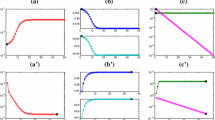Abstract
It is a common belief that the Tikhonov scheme with the \({\|\cdot\|_{L_2}}\)-penalty fails to reconstruct a sparse structure with respect to a given system {ϕ i }. However, in this paper we present a procedure for the sparse recovery, which is totally based on the standard Tikhonov method. This procedure consists of two steps. At first the Tikhonov scheme is used as a sieve to find the coefficients near ϕ i , which are suspected to be non-zero. Within this step the performance of the standard Tikhonov method is controlled in some sparsity promoting space rather than in the original Hilbert one. In the second step of the proposed procedure, the coefficients with indices selected in the previous step are estimated by means of the data functional strategy. The choice of the regularization parameter is a crucial issue for both steps. We show that a recently developed parameter choice rule called the balancing principle can be effectively used here. We also present the results of computational experiments giving the evidence of the reliability of our approach.
Similar content being viewed by others
References
Anderssen, R.: The linear functional strategy for improperly posed problems. Inverse problems (Oberwolfach, 1986). Int. Schriftenreihe Numer. Math. 77, 11–30 (1986)
Bauer F., Mathé P., Pereverzev S.V.: Local solutions to inverse problems in geodesy: The impact of the noise covariance structure upon the accuracy of estimation. J. Geodesy 81, 39–51 (2007)
Bonesky T., Bredies K., Lorenz D.A., Maass P.: A generalized conditional gradient method for nonlinear operator equation with sparsity constraints. Inverse Probl. 23, 2041–2058 (2007)
Böttcher A., Hofmann B., Tautenhahn U., Yamamoto M.: Convergence rates for Tikhonov regularization from different kinds of smoothness conditions. Appl. Anal. 85, 555–578 (2006)
Burger M., Osher S.: Convergence rates of convex variational regularization. Inverse Probl. 20, 1411–1421 (2004)
Daubechies I., Defrise M., De Mol C.: An iterative thresholding algorithm for linear inverse problems with a sparsity constraint. Commun. Pure Appl. Math. 57, 1413–1457 (2004)
Donoho D.: Statistical estimation and optimal recovery. Ann. Stat. 22, 238–270 (1994)
Donoho D.: Compressed sensing. IEEE Trans. Inform. Theory 52, 1289–1306 (2006)
Engl H.W., Hanke M., Neubauer A.: Regularization of Inverse Problems. Kluwer Academic Publishers, Dordrecht (1996)
Goldenshluger A., Pereverzev S.V.: Adaptive estimation of linear functions in Hilbert scales from indirect white noise observation. Probab. Theory Relat. Field 118, 169–186 (2000)
Hansen P.C.: Regularization tools, a MATLAB package for analysis of discrete regularization problems. Numer. Algorithm 6, 1–35 (1994)
Hofmann B., Kaltenbacher B., Pöschl C, Scherzer O.: A convergence rates results in Banach spaces with non-smooth operators. Inverse Probl. 23, 987–1010 (2007)
Lu J., Engl H.W., Machne R., Schuster P.: Inverse bifurcation analysis of a model for mammalian G 1/S regulatory module. Lecture Notes in Bioinformatics 4414, 168–184 (2007)
Malioutov, D.M.: A sparse signal reconstruction perspective for source localization with sensor arrays. Massachusetts Institute of Technology, Dissertation (2003)
Mathé P., Pereverzev S.V.: Optimal discretization of inverse problems in Hilbert scales. Regularization and self-regularization of projection methods. SIAM J. Numer. Anal. 38, 1999–2021 (2001)
Mathé P., Pereverzev S.V.: Direct estimation of linear functionals from indirect noisy observations. J Complex. 18, 500–516 (2002)
Mathé P., Pereverzev S.V.: Geometry of linear ill-posed problems in variable Hilbert scales. Inverse Probl. 19, 789–803 (2003)
Mathé P., Pereverzev S.V.: Regularization of some linear ill-posed problems with discretized random noisy data. Math. Comput. 75, 1913–1929 (2006)
Neubauer A.: An a posteriori parameter choice for Tikhonov regularization in Hilbert scales leading to optimal convergence rates. SIAM J. Numer. Anal. 25, 1313–1326 (1988)
Neubauer A.: Estimation of discontinuous solutions of ill-posed problems via adaptive grid regularization. J. Inv. Ill posed Probl. 14, 705–716 (2006)
Ramlau R., Teschke G.: A Tikhonov-based projection iteration for nonlinear ill-posed problems with sparsity constraints. Numer. Math. 104, 177–203 (2006)
Author information
Authors and Affiliations
Corresponding author
Rights and permissions
About this article
Cite this article
Lu, S., Pereverzev, S.V. Sparse recovery by the standard Tikhonov method. Numer. Math. 112, 403–424 (2009). https://doi.org/10.1007/s00211-009-0214-x
Received:
Revised:
Published:
Issue Date:
DOI: https://doi.org/10.1007/s00211-009-0214-x




